How to Prune an Apple Tree
- February 7, 2024
- 0 comment
Pruning an apple tree is a crucial horticultural practice that can significantly influence the health, productivity, and appearance of your tree. It involves selectively removing parts of the tree, such as branches, buds, or roots.

Effective pruning can encourage the growth of strong, healthy branches that will bear high-quality fruit. This guide provides a comprehensive overview of how to prune an apple tree, including the best time to prune, the tools you’ll need, and a step-by-step approach.
List on How to Prune an Apple Tree
- Inspect the Tree
- Remove Dead, Diseased, or Damaged Wood
- Open Up the Canopy
- Thin Out Dense Areas
- Shape the Tree
- Make Clean Cuts
- Clean Up
Best Time to Prune
The ideal time for pruning apple trees is during the late winter or early spring, just before the new growth starts. This timing helps prevent the tree from being exposed to harsh winter conditions with open wounds and ensures that the cuts heal quickly in spring. However, removing dead, damaged, or diseased branches can be done at any time of the year as soon as they are noticed.
Tools You Will Need
Pruning Shears
For pruning branches up to ¾ inches thick, using the correct pruning shears is key. Bypass pruners are best suited for this job, as their sharp, scissor-like action ensures a clean, precise cut. This not only aids in the tree’s healing process but also promotes healthy growth. Making sure to use the right tool for branches of this size is essential for effective pruning and maintaining the tree’s overall health.
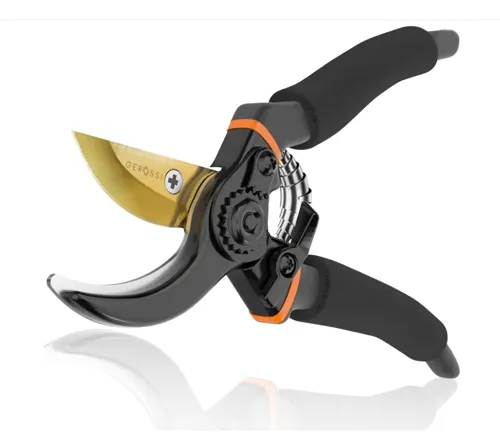
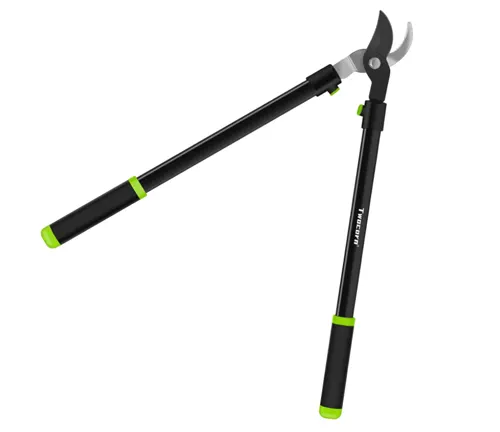
Loppers
When dealing with branches that range from ¾ inches to 1½ inches in diameter, loppers are the go-to tool. Loppers, with their long handles and powerful cutting mechanism, provide the extra leverage needed to cleanly cut through thicker branches. This not only makes the task more efficient but also reduces the strain on the gardener. The clean cuts made by loppers are crucial for the tree’s rapid healing and continued health. Their design allows for precise control over the cutting process, ensuring that each cut is made in the best interest of the tree’s growth and structural integrity.
Pruning Saw
For pruning larger branches over 1½ inches in diameter, a pruning saw is indispensable. Designed to cut through thick wood, pruning saws feature serrated blades that enable clean, efficient cuts, essential for the tree’s quick healing. Their design allows for precision, making them ideal for shaping and maintaining the tree’s health and appearance with minimal risk of damage.
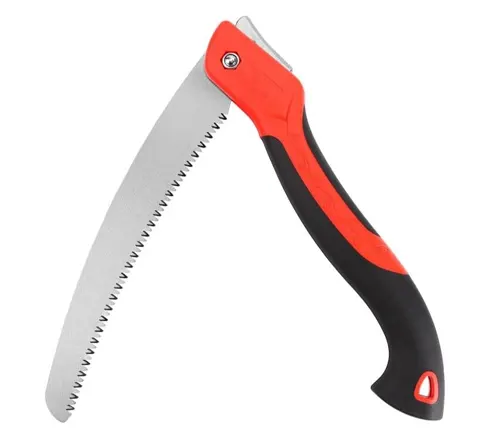
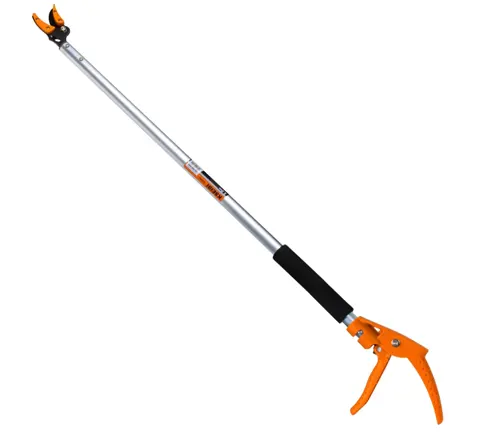
Pole Pruner
For trimming hard-to-reach branches from the ground, a pole pruner is a perfect tool. It features a long handle with a cutting mechanism at the top, enabling safe and precise pruning of high branches without a ladder. This tool simplifies maintaining the upper sections of trees, ensuring comprehensive care and shaping.
Gloves
Gardening gloves serve as crucial protection for your hands, safeguarding against cuts, scrapes, and irritations from plants and chemicals. They also enhance grip on tools, reducing fatigue and increasing safety. Available in various materials, they cater to different gardening tasks, ensuring comfort and protection during any gardening activity.

Step-by-Step Guide to Pruning
1. Inspect the Tree
Start with a careful examination of your apple tree, closely scrutinizing it for any signs of branches that are dead, afflicted by disease, or have sustained damage. These branches are the most critical to identify and remove as your initial step in the pruning process.
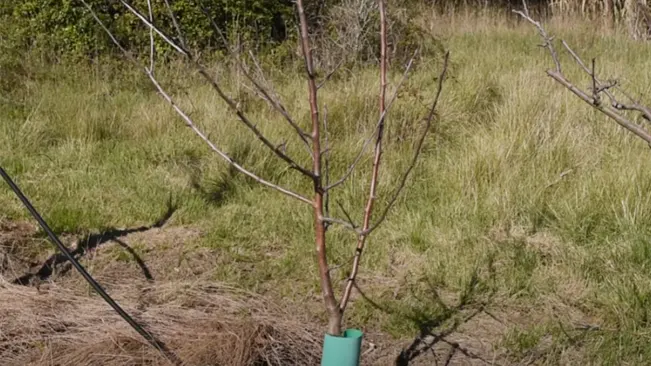
This thorough inspection is essential to ensure the health and productivity of your tree, as removing these problematic branches can prevent the spread of disease and encourage the growth of healthy, new branches.
2. Remove Dead, Diseased, or Damaged Wood
Select the right tool based on the thickness of the branch you need to remove, ensuring it’s suited for the task at hand. With precision and care, excise any parts of the wood that appear unhealthy, taking care to cut all the way back to the area where the tissue is still healthy.
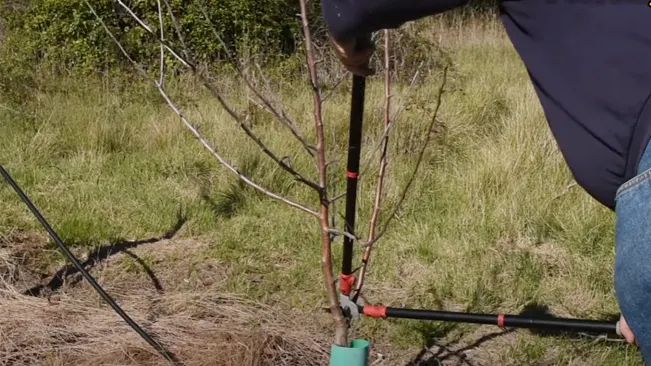
This careful approach is crucial as it helps halt the progression of any disease within the tree, promoting a healthier growth environment. It’s not just about removing the visibly affected parts; it’s about ensuring the continued health and vitality of the tree by meticulously cutting back to where the tree is still strong and disease-free.
3. Open Up the Canopy
To enhance air circulation and light exposure within the canopy, it’s essential to eliminate any branches that intersect or rub against one another.

This proactive measure not only improves the overall health of the plant but also significantly diminishes the likelihood of disease occurrence, ensuring a more robust and thriving growth.
4. Thin Out Dense Areas
When a tree exhibits areas of excessive branch density, it’s crucial to strategically thin out these sections to achieve a uniform distribution of light throughout the canopy. This careful management is especially important as adequate sunlight exposure is a key factor in the development of fruit. By selectively removing some branches, we can ensure that light penetrates more evenly, promoting not only healthier fruit growth but also contributing to the overall vitality and productivity of the tree.
5. Shape the Tree
Pruning your tree to maintain a specific structure, such as a modified central leader or a vase shape, is pivotal for enhancing fruit yield. These particular shapes are not just aesthetically pleasing but are designed to optimize the tree’s fruit-producing capabilities.
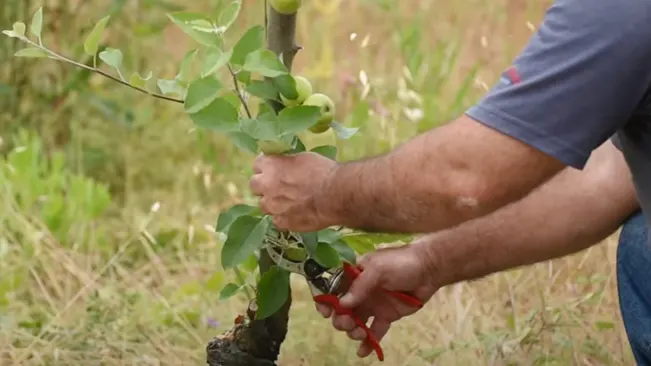
By carefully shaping the tree through selective pruning, you encourage a more efficient distribution of resources and energy throughout the tree, which in turn can lead to a more abundant and healthier harvest.
6. Make Clean Cuts
When pruning, it’s crucial to make clean cuts at a slight angle away from the bud. This technique is not just about precision; it serves a vital purpose in promoting water runoff from the cut surface.
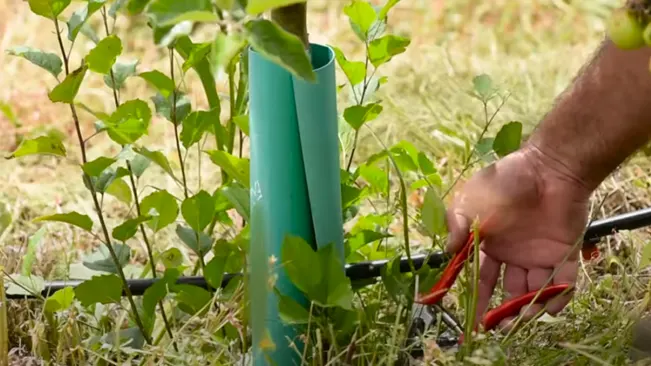
By doing so, you significantly reduce the chances of water accumulation, which can lead to disease. This careful approach to cutting helps maintain the tree’s health and longevity by minimizing the risk of infection and ensuring that the wounds heal properly and efficiently.
7. Clean Up
After completing your pruning session, it’s important to tidy up by removing all the severed branches and leaves from the area. This step is not just about keeping your garden neat; it plays a crucial role in disease prevention.
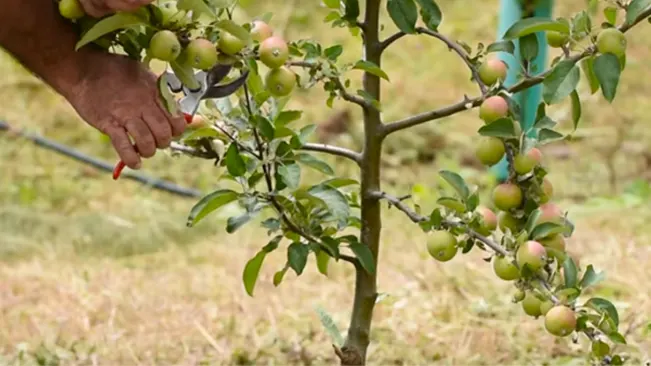
By disposing of the debris, you eliminate potential breeding grounds for pathogens that could spread disease to your trees. This practice ensures that your garden remains healthy and reduces the risk of future infestations.
Aftercare
Caring for your apple tree after pruning is essential for its recovery and overall health. It’s important to ensure the tree gets sufficient water to keep the soil consistently moist, but be careful to avoid overwatering, which can be detrimental. Mulching around the tree base is beneficial for moisture retention, temperature control, and weed suppression. Additionally, providing the right fertilizers will replenish essential nutrients, supporting the tree’s growth and vitality. These actions are key to nurturing a strong, productive apple tree ready to yield a generous harvest.
Related Topic
- When is the Best Time to Prune Trees
- How to Prune Peach Trees
Conclusion
Pruning is crucial for maintaining an apple tree’s health and enhancing its fruit production. By adhering to the recommended practices, you can ensure your tree remains vibrant and fruitful. It’s important to prune conservatively, as excessive pruning can harm the tree. If you find more pruning is necessary, you can always do so in the next season. This careful approach helps maintain the tree’s well-being and ensures a steady supply of delicious apples for years to come.
FAQs
- When is the best time to prune an apple tree?
The ideal time to prune an apple tree is during the late winter or early spring before new growth starts. This helps the tree to heal quickly and reduces the risk of disease. - Why is it important to prune apple trees?
Pruning is essential for maintaining the health and productivity of an apple tree. It helps to remove dead or diseased branches, improve air circulation and sunlight penetration, and encourage the growth of strong, fruit-bearing branches. - Can I prune an apple tree in summer?
While the best time to prune is in late winter or early spring, light pruning can be done in summer to remove any dead or diseased wood or to shape the tree lightly without stimulating too much new growth that may not harden off before winter. - How much of the tree should I prune at one time?
Generally, it’s advised not to remove more than 25-30% of the tree’s canopy in a single year to avoid stressing the tree. - What tools do I need for pruning an apple tree?
Essential tools include pruning shears for small branches, loppers for medium branches, a pruning saw for large branches, and possibly a pole pruner for high branches. Always ensure tools are sharp and clean. - How do I make proper pruning cuts?
Make cuts at a slight angle, about 1/4 inch above an outward-facing bud or branch. Ensure the cut is clean and smooth to promote quick healing. - What is the difference between pruning and thinning?
Pruning involves removing parts of the tree to improve its shape and health, while thinning specifically refers to removing some branches to reduce the density of the tree’s canopy, improving light penetration and air circulation. - Should I apply a wound dressing after pruning?
It’s generally not recommended to apply wound dressing to pruning cuts. Trees are capable of sealing their own wounds. Wound dressings can sometimes inhibit this natural healing process. - How do I deal with large branches?
For large branches, use the three-cut method to prevent bark tearing. First, make a notch on the underside of the branch a few inches from the trunk. Then, cut through the branch from the top, a few inches out from the first cut, to remove the weight of the branch. Finally, make a clean cut close to the trunk to remove the stub. - Can pruning affect fruit production?
Yes, proper pruning can enhance fruit production by improving the structure of the tree, increasing sunlight exposure and air circulation, and focusing the tree’s energy on producing high-quality fruit. However, over-pruning can reduce fruit yield, so it’s important to prune judiciously.
Have tips or questions on apple tree pruning? Drop a comment below to share your experiences or seek advice. Let’s grow some fantastic apples together!

Charles Hayes
Forestry AuthorI'm Charles Hayes, I bring over 15 years of specialized expertise in landscaping and woodworking, blending artistic design with sustainable environmental stewardship. My career, fueled by a profound passion for the natural world, encompasses extensive education and hands-on experience in creating harmonious, eco-friendly outdoor spaces and responsibly managing forest resources. Recognized for my professional standing, I am committed to continuous learning and certification in cutting-edge practices. My expertise is not only reflected in my work but also in my contributions to community projects, educational workshops, and collaborations with industry leaders. As an authoritative voice in my field, I strive to share knowledge and promote environmentally conscious approaches, making me a trusted resource in landscaping and forestry.




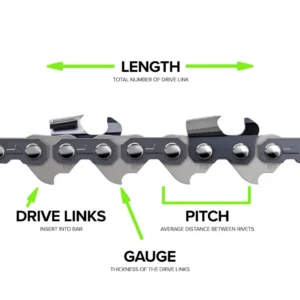








Leave your comment